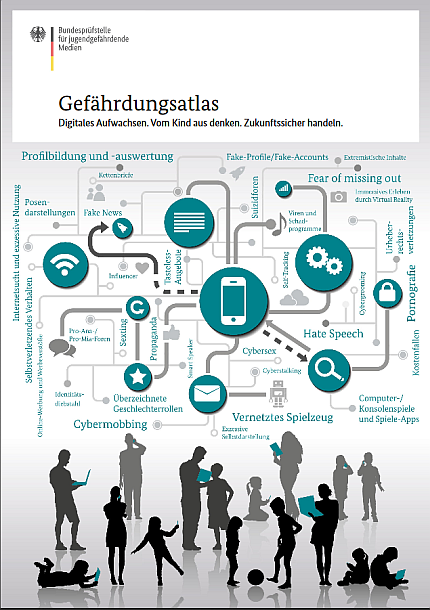Federal Review Board for Media Harmful to Young People Publishes Hazard Atlas
As part of an overall youth policy strategy of the federal and state governments to further develop child and youth media protection to meet the requirements of digitization, the strategy process "Digitales Aufwachsen. Thinking from the child. Future-proofing." based at the Federal Review Board for Media Harmful to Young Persons (BPjM).
The first premise of the strategy process is to think about child and youth media protection from the child's perspective. The declared aim is to ensure that the rights to protection, empowerment and participation enshrined in the United Nations Convention on the Rights of the Child also take effect in the digital sphere. The process, which is part of a long-term FUTURE WORKSHOP, aims to organize intelligent opportunity and risk management for all stakeholders who are responsible for ensuring that children and young people grow up well with media.
The risk atlas developed by the JFF - Institute for Media Education in Research and Practice in cooperation with the Leibniz Institute for Media Research │Hans Bredow Institute (HBI) is the first result of the FUTURE WORKSHOP and the necessary knowledge base for the further work process.
Following the claim to think from the child's point of view, the reality of life of children and adolescents in the context of media use as well as their media use behavior are presented first. The mediatization and digitalization of all areas of children's and young people's lives and the resulting commercialization of their lives become clear. Findings on the media usage behavior of children and adolescents are presented in a structured way according to media activities along an age cohort (2- to 6-year-olds, 6- to 13-year-olds and approx. 12- to 18-/19-year-olds) and placed in educational contexts.
The diversity and ubiquity of media use, especially with regard to interaction and communication, illustrates the need for a reorientation of the state's mandate to protect children and young people with regard to media in order to enable them to participate in the media without any worries.
The Hazard Atlas contains an overview of 35 media phenomena that are associated with threats to carefree participation.
In the context of the presentation of focal points of the expert discussion and the points of contact of children and young people with the phenomena, in addition to the hazards, also promoting functions for the personality development of children and young people are taken into consideration, which are partly also associated with the phenomena and justify precisely the children's right to participation in digital media use. The various roles in which children and adolescents can come into contact with the media phenomena are also illuminated.
Within the framework of a concluding child rights classification, it becomes clear that the protection of children and young people in the media requires a reorientation of its protection goals and instruments in order to guarantee carefree participation in digital media via infrastructural protection and help mechanisms in the offers and orientation for children, young people and educators. Providers are called upon to design their offerings infrastructurally in such a way that default settings as well as protection and help mechanisms are age-appropriate, effectively protecting younger users from dangers and enabling carefree participation.
- Download: Danger atlas (PDF)
- BPjM: Press release

